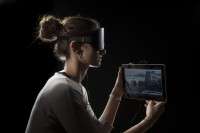Clearer future for blind thanks to vOICe device

New findings from researchers in our Department of Psychology could pave the way for better treatments for blind and partially-sighted people using the revolutionary sensory substitution device, 'The vOICe'.
The software, first developed by Dutch engineer Dr Peter Meijer, is free to use and works by converting camera images into sounds. A phone app based on the system for Android, already downloaded over 100,000 times, is enabling people around the world to build mental images of the objects around them.
Previous tests using the device found that, even without any training, performances of those using The vOICe exceeded the levels for current, and expensive, invasive techniques for vision restoration, such as stem cell implants and retinal prostheses. Costs for retinal implants can be prohibitively high and in many cases will not be suitable for patients.
Now a new study from researchers at the University, that focused on how much information people need in order to recognise objects through sound, demonstrates that the information required is significantly lower than previously thought.
Dr Michael Proulx explains: "Through our study we found that naive, untrained users were able to identify objects with greater accuracy than expected by chance. The fact that this was with low resolution images turned into sound is impressive. The pattern of results allows us to infer how the processing of auditory information in the brain progresses before being used in a visual-like way. This is one of the first studies to examine the initial stages of how the information might be routed through circuits in the brain."
The study, which is published in the journal Multisensory Research, presented both blind and sighted listeners with six images or tactile objects and required them to match one with a soundscape created using The vOICe. The researchers varied the pixel resolution from images processed by the device – from 4px x 4px (a hard to define grainy image) to 32px x 32px (a clearer, more detailed image) – in order to gauge optimum performance for recognition.
Dr David Brown, added: "A better understanding of how the brain processes the information from The vOICe not only allows us to develop more effective algorithms and training methods but also may have implications for low resolution retinal implants in that sensory substitution may be used in conjunction to train the brain to understand the information provided by implants."
According to the World Health Organisation, around 40 million people in the world are blind, while another 250 million have some form of visual impairment. With an increase in age-related disorders, such glaucoma and diabetes, these numbers look set to rise.
Researchers now hope to extend tests using The vOICe sensory substitution device and to publicise its availability in order to increase numbers for those using and experimenting with the technology.
More information: "Visual Objects in the Auditory System in Sensory Substitution: How Much Information Do We Need?" booksandjournals.brillonline.c … 63/22134808-00002462
Provided by University of Bath



















